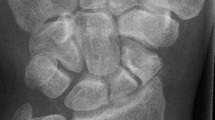Abstract
Background
The aim of this study was to quantify the compensatory movements of the shoulder and elbow in patients with congenital radioulnar synostosis during 10 activities of daily living (ADL).
Methods
Maximum and minimum joint angles and range of motion were measured by use of a motion capture system in seven patients and seven matched controls. The forearm was fixed in 0° of rotation in four patients and in 20° of pronation in three patients.
Results
The main compensatory movements were shoulder internal/external rotation during five ADL tasks, shoulder abduction/adduction and elbow flexion/extension during three tasks, and shoulder flexion/extension during two tasks. These compensatory movements were observed mainly when turning a key and drawing.
Conclusions
Patients with congenital radioulnar synostosis in nearly neutral rotation could perform all ADL tasks with the aid of compensatory movements of the shoulder and elbow.
Similar content being viewed by others
References
Cleary JE, Omer GE Jr. Congenital proximal radio-ulnar synostosis: natural history and functional assessment. J Bone Joint Surg Am 1985;67:539–545.
Ogino T, Hikino K. Congenital radio-ulnar synostosis: compensatory rotation around the wrist and rotation osteotomy. J Hand Surg [Br] 1987;12:173–178.
Simmons BP, Southmayd WW, Riseborough EJ. Congenital radioulnar synostosis. J Hand Surg [Am] 1983;8:829–838.
Blauth W, von Rothkirch T. [Surgical treatment of isolated, congenital radio-ulnar synostoses]. Z Orthop Ihre Grenzgeb 1989;127:631–638.
Yammine K, Salon A, Pouliquen JC. Congenital radioulnar synostosis: study of a series of 37 children and adolescents. Chir Main 1998;17:300–308.
Raiss P, Rettig O, Wolf S, Loew M, Kasten P. [Range of motion of shoulder and elbow in activities of daily life in 3D motion analysis]. Z Orthop Unfall 2007;145:493–498.
Rettig O, Wolf S. Upper extremity — optical marker based joint center calculation and elbow flexion angle determination. Gait Posture 2004;20S:105.
Rettig O, Wolf S. An upper extremity model based on optimized joint centres and axes. Gait Posture 2005;22S:19.
Offenbacher M, Ewert T, Sangha O, Stucki G. Validation of a German version of the “Disabilities of Arm, Shoulder and Hand” questionnaire (DASH-G). Z Rheumatol 2003;62:168–177.
Germann G, Wind G, Harth A. [The DASH (Disability of Arm-Shoulder-Hand) Questionnaire — a new instrument for evaluating upper extremity treatment outcome]. Handchir Mikrochir Plast Chir 1999;31:149–152.
Morrey BF, An KN, Chao EY. The elbow and its disorders. Philadelphia: Saunders; 1985. p. 73–91.
Wu G, van der Helm FC, Veeger HE, Makhsous M, Van Roy P, Anglin C, et al. ISB recommendation on definitions of joint coordinate systems of various joints for the reporting of human joint motion. Part II. Shoulder, elbow, wrist and hand. J Biomech 2005;38:981–992.
Carman AB, Milburn PD. Determining rigid body transformation parameters from ill-conditioned spatial marker co-ordinates. J Biomech 2006;39:1778–1786.
Chiari L, Della CU, Leardini A, Cappozzo A. Human movement analysis using stereophotogrammetry. Part 2. Instrumental errors. Gait Posture 2005;21:197–211.
Chang LY, Pollard NS. Constrained least-squares optimization for robust estimation of center of rotation. J Biomech 2007;40:1392–400.
Doorenbosch CA, Harlaar J, Veeger DH. The globe system: an unambiguous description of shoulder positions in daily life movements. J Rehabil Res Dev 2003;40:147–155.
Murase T, Tada K, Yoshida T, Moritomo H. Derotational osteotomy at the shafts of the radius and ulna for congenital radioulnar synostosis. J Hand Surg [Am] 2003;28:133–137.
Rau G, Disselhorst-Klug C, Schmidt R. Movement biomechanics goes upwards: from the leg to the arm. J Biomech 2000;33: 1207–1216.
Vasen AP, Lacey SH, Keith MW, Shaffer JW. Functional range of motion of the elbow. J Hand Surg [Am] 1995;20:288–292.
Morrey BF, Askew LJ, Chao EY. A biomechanical study of normal functional elbow motion. J Bone Joint Surg Am 1981;63:872–877.
Kreulen M, Smeulders MJ, Veeger HE, Hage JJ. Movement patterns of the upper extremity and trunk associated with impaired forearm rotation in patients with hemiplegic cerebral palsy compared to healthy controls. Gait Posture 2007;25:485–492.
Petuskey K, Bagley A, Abdala E, James MA, Rab G. Upper extremity kinematics during functional activities: three-dimensional studies in a normal pediatric population. Gait Posture 2007;25:573–579.
Buckley MA, Yardley A, Johnson GR, Carus DA. Dynamics of the upper limb during performance of the tasks of everyday living: a review of the current knowledge base. Proc Inst Mech Eng [H] 1996;210:241–247.
Clark MC, Czaja SJ, Weber RA. Older adults and daily living task profiles. Hum Factors 1990;32:537–549.
Safaee-Rad R, Shwedyk E, Quanbury AO, Cooper JE. Normal functional range of motion of upper limb joints during performance of three feeding activities. Arch Phys Med Rehabil 1990;71:505–509.
Author information
Authors and Affiliations
About this article
Cite this article
Kasten, P., Rettig, O., Loew, M. et al. Three-dimensional motion analysis of compensatory movements in patients with radioulnar synostosis performing activities of daily living. J Orthop Sci 14, 307–312 (2009). https://doi.org/10.1007/s00776-009-1332-0
Received:
Accepted:
Published:
Issue Date:
DOI: https://doi.org/10.1007/s00776-009-1332-0




